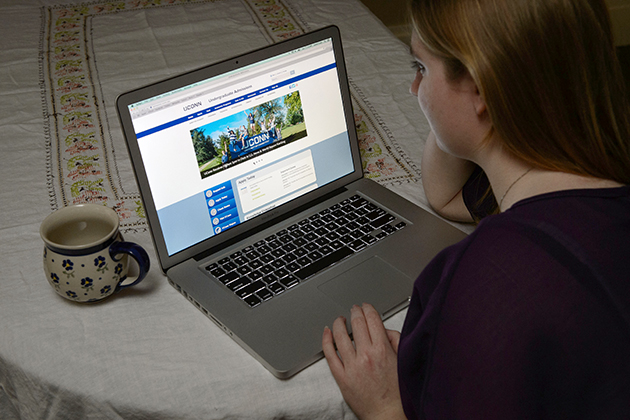
The number of high school students seeking admission to UConn’s Storrs campus next fall has jumped significantly over last year’s figures, comprising a pool of potential freshmen with even higher average SAT scores and more diversity than previous years’ classes.
More than 29,500 students applied as of Wednesday’s due date, a 10 percent increase over last year’s number. The average SAT score of the applicants is 12 points higher than last year’s, and the number of minority applicants also increased by nearly 16 percent – an important consideration in UConn’s goal to increasingly diversify its student body.
The jump in UConn applications runs counter to national and regional trends in which declines in the number of high school graduates have caused many universities to see their applications and enrollments level off or decrease.
Nothing speaks more loudly about the academic reputation, attractiveness and value of a university like a huge rise in applications. (President Susan Herbst)
But while the population of potential applicants to universities nationwide is declining, UConn’s new application figures show it’s capturing a larger and more talented piece of the shrinking pie – a fact that UConn officials attribute to the strength of its academic offerings, its affordability, and its commitment to targeted growth in key programs.
Indeed, several of those programs – including engineering, business, digital media, and allied health sciences – are among the disciplines that saw significant increases in interest from the potential new UConn students who applied for admission.
The increase in applications also comes as UConn is investing in new faculty, updating its academic plan, and planning for the Next Generation Connecticut initiative to revolutionize its STEM (science, technology, engineering, and math) curricula over the next 10 years.
“Nothing speaks more loudly about the academic reputation, attractiveness, and value of a university like a huge rise in applications,” says President Susan Herbst. “It is a widespread recognition of the excellence of our faculty, our student experience, and our alumni.
“We are grateful, daily, for the investment by our governor, legislature, and the many donors who make this such an attractive institution to students in Connecticut and around the globe,” she says.
Parents and students apply to colleges based on excellence and value, Herbst says, adding, “This is outstanding data-based recognition of our affordability, and demonstrates value like no other statistic possibly can.”
The numbers have more than doubled since 2001, when the University received about 13,600 applications.
UConn’s reputation for academic excellence, value, commitment to the environment, and service have been recognized by several outside entities in recent years, all of which also are thought to be contributing to the upswing in applications.
Last month, UConn was named No. 25 on the Kiplinger’s Personal Finance’s list of 100 best values in public colleges for 2013-2014, marking the second consecutive year the University has earned that spot.
It’s also ranked No. 19 on the annual U.S. News & World Report’s ranking of the best public universities – UConn’s highest ranking to date – and holds the No. 1 spots for environmental stewardship on both the Sierra Club’s “Cool Schools” list and Universitas Indonesia’s GreenMetric World Ranking.
And last fall, the Connecticut General Assembly’s nonpartisan Program Review and Investigation Committee issued a preliminary report that compared UConn with peer flagship institutions, saying its in-state affordability levels and trends compare favorably to the flagship median by every measure. It also noted that when looking at net price – the price actually paid by students – UConn ranked 39th, or the 11th lowest, among public flagships.
Nathan Fuerst, UConn’s director of admissions, says those kinds of external rankings and reports can be a very important measure for applicants and their families as they consider UConn. University officials also have been more aggressively reaching out to students statewide and nationally who may be good candidates for UConn, he says, and it seems to be reflected in the high quality of this year’s applicant pool.
The numbers are particularly gratifying when considering the landscape of secondary education, in which the U.S. is seeing declines in its number of high school graduates after a significant period of growth.
The Western Interstate Commission for Higher Education says in a study that graduating classes are predicted to consistently decline nationwide and particularly in the Northeast, matching the drop in birthrates that began with the 2007 recession. As a result, its report says, “Postsecondary institutions will likely face greater competition for fewer recent high school graduates because of absolute declines in the size of that group.”
“The fact that we’re seeing an increase in applications at UConn despite a decline in the number of students eligible to go to college is a really good sign,” Fuerst says. “We’re also seeing an increase in the quality of the applicant pool, which is exciting for us as we work to select the very best among them to come to UConn.”
Fuerst says he and others in his office also receive a number of emails from applicants who want to update admissions officers on new honors they’ve received, or to underscore how eager they are to come to UConn if accepted.
“Anecdotally, I do see an uptick this year in the number of those emails, and it’s always gratifying to hear how excited they are and how deeply they feel about UConn as the right place for them,” he said.
The University will begin notifying applicants with offers of admission starting March 1, with the targeted new class of Storrs freshmen estimated to be around 3,550 students. UConn will continue to accept applications for its regional campuses at Avery Point, Greater Hartford, Stamford, Torrington, and Waterbury until July 1.


